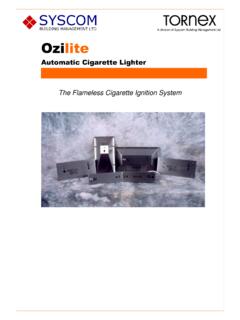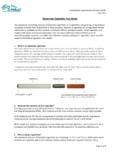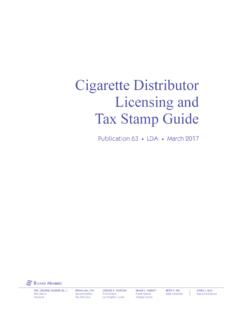Transcription of ADDITIVES, CIGARETTE DESIGN and TOBACCO …
1 additives , CIGARETTE DESIGN and TOBACCO PRODUCT REGULATION A REPORT TO: WORLD HEALTH ORGANIZATION TOBACCO FREE INITIATIVE TOBACCO PRODUCT REGULATION GROUP KOBE, JAPAN 28 JUNE-2 JULY 2006 WIGAND, MA, , MAT, SMOKE-FREE KIDS, INC. MT PLEASANT, MI 48804 1 FOREWARD This paper is written with the perspective of over 15 years experience and involvement in TOBACCO science and chemistry. As the Vice President of Research, Development and Environmental Affairs for Brown & Williamson TOBACCO Corporation, I became intimately aware of the philosophy of additive(s) use, and of how the industry s lawyers buffered the meaningful disclosure of these additives . Most recently, I have served as the expert in the Dutch litigation concerning the Netherlands transposition of EU Directive 2001/37/EC into Dutch law ( Dutch Decree ).
2 The Dutch Decree requires manufacturers and importers of TOBACCO products to disclose all additives by quantity, type and by brand name. Unsurprisingly, the TOBACCO industry initiated litigation to prevent the enactment of this law. The Dutch Decree has been tested in the Dutch Courts with a preliminary opinion rendered, and the legal action is pending final resolution. My knowledge of both intentional and unintentional additives (contaminants) was used to respond to the industry s argument that additive disclosure is not only scientifically superfluous, but also violates the industry s trade secrets. It is my opinion that an adequate regulatory framework for additives requires the industry to disclose both intentional and unintentional additives or concomitants. The Dutch Decree as well as the WHO FCTC address only the former concern.
3 However, as I discuss in Part III of this report, unintentional additives also pose risks to public health. For example, packaging inks, microflora, and solid contaminants such as styrofoam, are among the unintentional ingredients that are inhaled by the smoker. The effective regulation of TOBACCO products should either prohibit or restrict unintentional additives that pose risks to public health. 2 TABLE OF CONTENTS I. CIGARETTE DESIGN A. Raw Materials B. TOBACCO Types 1. Flue Cured TOBACCO 2. Burley TOBACCO 3. Oriental TOBACCO C. Combustion By-Products D. Overview of Manufacturing E. Reconstituted TOBACCO (RECON) 1. Raw material components and composition of RECON 2.
4 How is Paper RECON made? a. Type I b. Type II 3. Band cast reconstituted TOBACCO (Dark RECON) 4. Add-ONS a. Expanded TOBACCO b. Stems c. Shorts II. INTENTIONAL additives A. The Industry s Treatment of additives in the United States B. The Industry s GRAS Argument C. Why the GRAS Argument is Bogus 1. Ingredients on the GRAS List Were Never Intended to be Burned a. How additives Change During Pyrolysis i. Sugars ii. Glycerol/PEG iii.
5 Cocoa 2. Ingredients on the GRAS List Were Never Intended to be Inahaled a. Biodetoxicfication Systems: The Lungs vs. The Body D. Other additives 1. Urea III. UNINTENTIONAL additives A. Agronomic Microorganisms 1. The Genus Bacillus 2. The Genus Clostridium 3. Fungi Aspergillus 4. Other microorganisms B. Pesticide/Herbicide/Insecticide/Suckerci de Residues 1. Maleic Hydrazide/Suckercides 2. Ethylenebisdithiocarbamate (EDBC) 3. Systemic Insecticides a. Methoprene (Kabat) 3 b. Phosphene C.
6 Elements and Heavy Metals D. Foreign Materials E. Other Extraneous Hazardous Chemicals IV. CONCLUSIONS V. FUTURE RESEARCH VI. ADDENDUM 4 INTRODUCTION Smallpox killed approximately 300 million people in the 20th century, three times the number of all war related deaths. Today, the scourge of smallpox has been eradicated. Smallpox has no animal reservoir and its infection is solely limited to humans. The congruency between smallpox and TOBACCO induced diseases is not trivial, and as smallpox did not discriminate between kings or serfs, neither does TOBACCO . The addicted adult user, the adolescent novice, and the innocent bystander are all vulnerable to the harms of TOBACCO . In 2005, the World Health Organization (WHO) decided to take action to protect the public from the harms of TOBACCO by devising a regulatory model for TOBACCO , the Framework Convention for TOBACCO Control (FCTC).
7 The FCTC sets in motion a series of actions directed at "denormalizing" TOBACCO , such as restriction on advertising and sponsorships, changes in packaging, and the proliferation of smoke free environments. The Convention, through the Conference of Parties (COP), Article 9, identified the need "for testing, measuring and regulating the contents and emissions of TOBACCO ." The need is critical indeed. TOBACCO products are not natural products that contain harmless ingredients. Rather, a typical CIGARETTE can contain numerous intentional additives . However, virtually nothing is known about these ingredients. Even worse, nothing is known about the unintentional additives that are the by-products of the growing, handling and manufacture of TOBACCO products. These unintentional additives or contaminants include pesticides, herbicides and ink from the packaging materials.
8 We are in the dark about how these unintentional additives are affected when burned in conjunction with nicotine and when combusted with other intentional additives . The objective of this manuscript is to produce a scientifically relevant instrument that will enhance the understanding of the role of both intentional and unintentional additives in the 5morbidity and mortality of TOBACCO products. Throughout this manuscript the terms additive, ingredient, and flavoring will be used synonymously. Although I limit discussion to additives in conventional cigarettes , the use of additives in non-conventional cigarettes and in other TOBACCO products is also pervasive. These areas are in need of attention, and future research on TOBACCO additives should include research into these devices.
9 This manuscript begins with a discussion about CIGARETTE DESIGN . In order to understand how additives function, one must first understand the DESIGN features of cigarettes . As we will see, some of these DESIGN features affect the delivery of additives . For example, the introduction of reconstituted TOBACCO or RECON, is the primary means by which ammonia chemistry and other chemicals are introduced into a CIGARETTE . RECON can be considered a chemical delivery system. After outlining CIGARETTE DESIGN , I will then address the topic of intentional additives . The industry argues that since all intentional additives are GRAS ( generally recognized as safe ) approved, then there is no need for disclosure of these additives . I explain why this argument is bogus. I also discuss some of the chemical properties of several of the additives that are typically used in US blended cigarettes (sugars, glycerol, etc.)
10 I then turn my discussion to unintentional additives . There are a variety of hazardous chemicals resulting not only from the soil in which TOBACCO is harvested, but also from the packaging in which cigarettes are housed. These chemical entities are typically ignored. However, any policy concerned with mitigating the harm caused by TOBACCO products needs to be mindful of the harm posed by unintentional additives . DESIGN While there are many different kinds of TOBACCO products ( , cigarettes , cigars, cigarillos, bidis, kreteks, pipe tobaccos, and smokeless products), the most common form of TOBACCO is the manufactured CIGARETTE . A CIGARETTE is a cylindrical roll of TOBACCO material mass contained in a non- TOBACCO or paper wrapper. Machine manufactured cigarettes (15-20,000/min) can be found in 5-8 mm in diameter and 70 -100 mm in length, predominately with a 15-25 mm in length matching diameter cellulose acetate filter plug.







